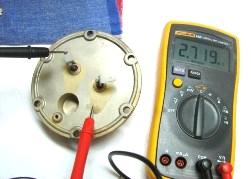Categories: Featured Articles » Sharing experience
Number of views: 29543
Comments on the article: 1
We independently carry out preventive maintenance of a water heater

According to unbiased statistics, more than two-thirds of all sold electric water heaters (boilers) are accumulative-type units.
And these devices, unlike flowing electric heaters, require regular correct preventive maintenance.
Preventive maintenance of boilers means removal of sludge deposited on the bottom, replacement of the magnesium anode and surface cleaning heating element (TENA) from the formed scale.
As a rule, depending on the individual characteristics of your tap water, the frequency of preventative maintenance storage water heater ranges from a year to a year and a half.
You can, of course, invite a master from the service center for this purpose, then he will make an appropriate note about the performed service and inspire virtual confidence in the warranty. However, for this service you will have to pay specific money, which can be used more worthily. Moreover, nothing is difficult in the prevention of the heater is not observed. And now you will see for yourself.
So the first thing we do is disconnect the boiler from the mains. And it is advisable to do this in advance, 12 hours before the start of work. It is not even a matter of observing electrical safety rules. Just for the work you need to completely drain the water from the tank. You understand what a "hot atmosphere" will be in the room when 80 or 100 liters of boiling water will drain into the sewer.
And yet, even in a completely drained tank, about a liter of hot water remains, which will certainly pour into your hands when dismantling the heater. Do you need this?
Now, our second action will be to drain the water from the boiler.
To do this, turn off the valve for supplying cold water to the tank. Then, fully unscrewing the hot water valve on the mixer, to balance the pressure inside the boiler, we will begin to drain the water through a tee specially installed on the inlet of the tank to remove water. If the tee was not installed when installing the boiler, then to drain the water you will have to unpack the cold tank inlet.
After the water has stopped flowing out, and this time directly depends on the capacity of the tank, you can start preventive work.
So, our third action will be the dismantling of the heater.
In order to get to the heating element and the magnesium anode, we need to remove the decorative plastic cover on the bottom of the boiler. Usually it is attached with several self-tapping screws, and has a control lamp integrated in the housing. Unscrew the screws, disconnect the lamp terminals from the thermostat and remove the cover.
Then, unscrewing the power wires, gently pulling down, release it from the grooves temperature controller. Now you will see a flange on which a heating element and a magnesium anode are mounted. Flanges are most often mounted on bolts located around the perimeter, or with a special bracket, which is fixed with one central bolt.
After all the bolts have been unscrewed, remove the flange along with the o-ring. Be careful when doing this. Those who carry out the dismantling of the heating element for the first time receive a slight shock from an incredible amount of dirt that spills into their hands. It happens that the flange does not even give in to efforts, abutting against the opening of the boiler by overgrown "coral" growths. Then you have to gradually pull it out, helping yourself with a screwdriver.
The fourth thing we do is separate the old magnesium anode. Rather, what is left of it (it happens that instead of the anode only an empty threaded rod sticks out).
Using the moment, we rake out all the trash that remains there from the inner cavity of the tank, and what we don’t get, we wash it out with a stream of water directed from the hose.
Our fifth case will be cleaning the surface of the heating element on the scale.
This can be done mechanically, gently brushing off the still moist layer of lime with a knife or screwdriver. When it dries, it will be harder to do. We bring the final shine with a fine sandpaper.
And you can also use the achievements of chemistry by placing the heater in a container of hot water for a while, in which acid or any household descaler is added.
The sixth thing we will do is screw the new magnesium anode into place, which you must first purchase in the store. Just do not forget the real diameter of the thread of your anode, so as not to get into trouble, as they come in from 4 to 8 mm.
Then we assemble the boiler in the reverse order.
The seventh action that we are taking is launching water into the boiler. Close the tee tap to drain the water and let the cold water into the tank. After water flows from the mixer, it can be concluded that the tank is full.
After making sure that there are no leaks through the flange, you can connect the boiler to the mains.
Mikhail Barsukov
See also at bgv.electricianexp.com
:
